#dungeons and dragons 5th edition stats
Text
The Blue Fairy

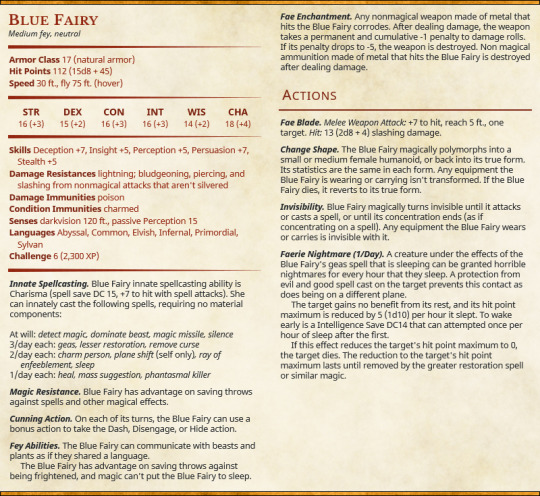
The Blue Fairy is the secret ruler of the city state north of Eshen ruling by charming its council as she acts a mix of secret ruler and patron to the council with her strong collection of abilities to support herself.
Well not evil she is oft selfish in her goals only prioritizing the city when it could cause major negatives to it or her in the long run.
She will readily hear council from those that can best her and leave her alone but if threatened with death she will readily plane shift away to avoid confrontation.
If death is not a threat to here she will instead seek to try and disable or dissuade the targets away from her using her magic to call animals from the town and/or charm people to avoid confrontation.
#arch fey#arch fae#fairy#arch fairy#fae#fey#lujordis#art#dnd oc#dnd oc art#d&d oc#d&d oc art#dungeons and dragons oc#dungeons and dragons art#dungeons and dragons 5th edition stats#dungeons and dragons#dungeons and dragons 5th edition#dungeons and dragons 5e#dnd 5th edition#dnd 5e#D&D 5th edition#D&D 5e#magic#spellcasting#CR 6#cr6#blue fairy#faerie nightmare#some abilities based on the night hag#cunning action
5 notes
·
View notes
Photo
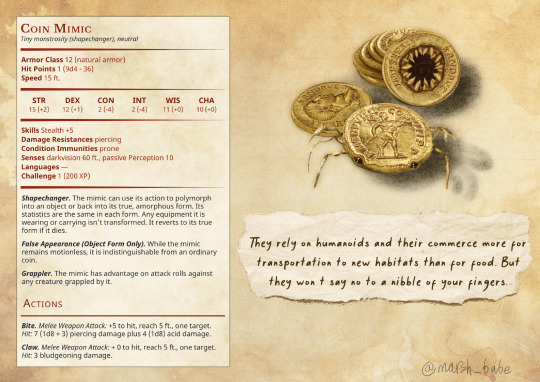
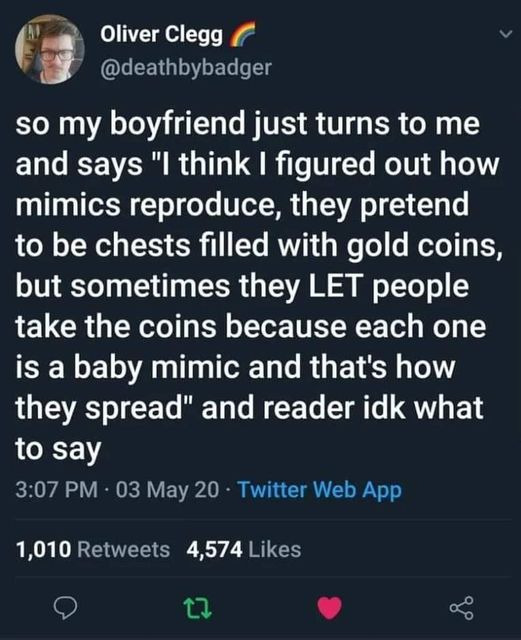
So let's talk about the idea of Coin Mimics...
Homebrew monster from u/Delicious-Jicama40 on Reddit.
447 notes
·
View notes
Photo

Creature: Horizon Mongrel
When stars collapse into black holes, not even light can escape the surface. But occasionally, very rarely when there is not a single pair of eyes in the universe even flitting towards the newly birthed black hole, something else can escape. Something that inherits the churning, black darkness and the intense gravity of its birthplace, and speeds away faster from that sinkhole of death than anyone can follow it.
Black holes incarnate. Many people ask questions about the origins of the horizon mongrels, the creatures called after the black boundary of certain death and crushing gravity near an imploded star. Very few people have answers that aren’t an overactive imagination. Where the mongrels really come from, no one is quite certain, but it’s clear that the patch of space that spits them out is darker and emptier than any other.
Flashing nightmares. Mongrels are solitary creatures that seem to be either completely uninterested in their own kind of entirely unaware of them. Rather, a mongrel seeks out places where the flow of spacetime is warped in some way, or even broken. Powerful graviturges often find themselves hunted by a mongrel, which is capable of great destruction should it ever arrive at its unfortunate victim’s doorstep. And as fast as it appears, it is gone - since they are often not much more than a flash of jaws and choking, crushing gravity, leaving nothing behind.
Slowing down time. The mongrels that have been studied seem to live at a faster pace than most creatures, slowing down their internal clock and allowing them to attain lifetimes of aeons. The only true weapon anyone has against a mongrel is to attempt to slow it, forcing it to experience time at a different speed, which seems to draw out some of its few weaknesses. Stopping a mongrel in its tracks entirely, well... it might just kill it.
#dnd#dnd5e#d&d#d&d5e#dungeons and dragon#5th edition dungeons and dragons#d&d homebrew#dev's homebrews#creature stat block#aberrations#cr12
366 notes
·
View notes
Photo
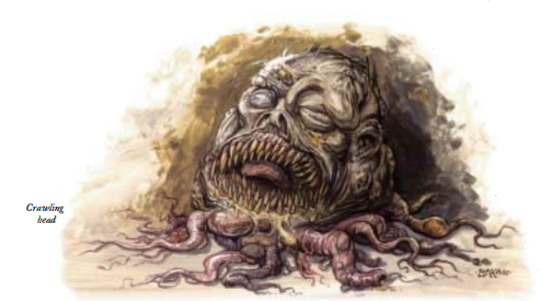
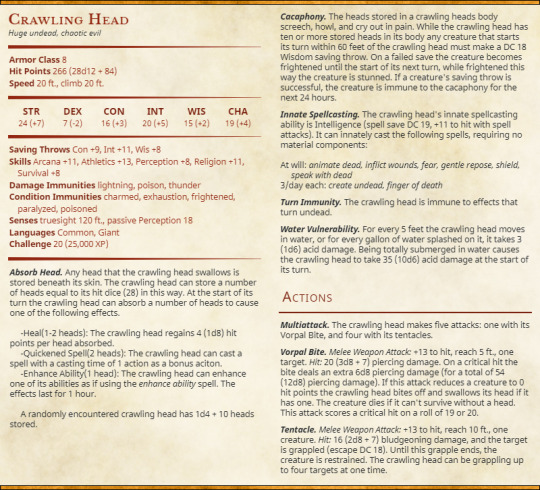
Happy (Early) Halloween Everyone. To celebrate I made a video on the Crawling Head from the 3.5e Fiend Folio and made some converted stats to pair with it. If you wanna see the video, here’s my channel vvvvvvvvvvvv
My Channel: https://www.youtube.com/channel/UCPcFsxfrenLv_Nx0oxSmBhA
#dnd#d&d#fiend#undead#zombie#giant#dungeons & dragons#Dungeons and Dragons#dungeons and dragons 5e#dnd 5e homebrew#dnd 5th edition#d&d 5th edition#d&d 5e homebrew#d&d stats#stat block#halloween#happy halloweeeeeeen#dungeon masters guide
24 notes
·
View notes
Text

The berserker statblock always lacked a certain punch for me. Throwing it at my players, it never really felt like they were fighting a barbarian, especially after the early levels. I ended up making what started out as a tougher version of the berserker, but quickly outpaced it in terms of difficulty.
(Word of warning, since rage gives it resistance to bludgeoning, piercing, and slashing, magical or not, take the CR of 7 with a grain of salt. Depends on the party you have.)
#dungeons and dragons#dungeons & dragons#D&D#d&d 5th edition#d&d homebrew#homebrew#barbarian#d&d barbarian#stat block
6 notes
·
View notes
Photo

Made a quick and easy Morbius stat block for all the Morbheads out there :)
7 notes
·
View notes
Text
Dungeons: The Dragons
What if Dungeons & Dragons was a Storytelling game in the vein of Vampire: The Requiem and such?
Obviously it would still be about adventurers going into dungeons to get loot, but with a new Chronicles of Darknessy twist. Why Storytelling instead of Storyteller, you might ask? Because the more formulaic structure of the former makes this easier, basically. Let's go!
So one of the things I struggled with while coming up with this was what the Inherent Type would be (see: Clan, Auspice, Path). The obvious answer might be race, but that didn't quite sit right with me. For one thing I wanted there to be an element of transformation, like a normal person can become an adventurer, and suddenly becoming an elf would be a bit weird. So by default your adventurers are humans who go through some transformation to become adventures. And my bestie @thydungeonguy finally cracked it when I was wondering what the obligatory skull logo would be like and he said "dragon skull." So it clicked: an adventurer has become infused with a dragon soul or something, and the five inherent types map to the five metallic dragons!
So next we have the Joined Type (see: Covenant, Tribe, Order), and this one was a lot easier. Going with classes was a bit too boring, so I just stole the five factions from 5th Edition, which can still serve to give you class-like abilities (evil-smiting abilities from the Order of the Gauntlet, for example).
Then there's the basic Powers (see: Disciplines, Gifts, Arcana). I think these come from the draconic type, with factions working more like the Covenants in Vampire where they can teach you miscalleanous skills like sorcery. I haven't figured out any particulars, including what to call these.
Onto the Power Stat (see: Blood Potency, Primal Urge, Gnosis). This is just Level, right? Like, you all agree this one should be called Level? Moving on.
The Morality/Integrity Stat (see: Humanity, Harmony, Wisdom) is a measure of how close you are to a Normal Man. The lower it goes, the more removed you are from being able to associate with people who have normal jobs instead of risking their lives going into dungeons for loot. If it's at 10, you can't actually go into dungeons. If it's at 0, they won't let you back into town, you're just too dungeonpilled now. Don't know what to call this. Normalcy, maybe?
There's also the Resource Stat (see: Vitae, Essence, Mana). I think here we have to depart from the usual formulas a bit and, instead of giving characters a pool of points to use, give them spell slots! Maybe even call them that, in which case the powers would be called Spells.
The Advanced Types (see: Bloodline, Lodge, Legacy) are Prestige Classes, which are called that even though there technically aren't classes.
Tell me what you think, and suggest names for the stuff I haven't named yet!
81 notes
·
View notes
Text
little thing i've been thinking about as of late:
How could one make the Octopath Travelers II in Dungeons and Dragons?
the rules i've set for myself are as follows:
no variant human. that is boring.
we're going for flavour over optimization but my stupid optimizer brain will nonetheless be the architect behind this all so Watch Out
Unearthed Arcana and things of that sort ARE allowed. UA is my dear wife and to leave her out of my house would be a crime most unforgivable
stats will be calculated using the point buy method, simply because that is much easier than working with the other methods
in a similar vein to the previous, pre-Mordenkainen's Monsters of the Multiverse stat increases and abilities for races will be used (my best friend the Air Genasi gets burnt by this but sacrifices must be made)
characters will range from level 10 (agnea) to level 14 (osvald)
this is what the characters would look like at the END of their journeys, so abilities like the One True Magic would be taken into account
i'll link pages describing all of the things i use, all of which will be from my dnd site of choice, the DND 5th Edition Wikidot Site
that being said...
Ochette, the Hunter
Race:
Tabaxi (+2 DEX, +1 CHA)
Class(es):
Revised Ranger - Beastmaster Conclave - Level 8
Paladin - Oath of the Ancients - Level 3
Feats (if any):
N/A
Stats:
STR - 14 (+2)
DEX - 19 (+4)
CON - 15 (+2)
INT - 10 (0)
WIS - 8 (-1)
CHA - 13 (+1)
Key Abilities/Explanations:
Tabaxi - Race: Ochette, while more of a fox than a cat, notably has many animal features similar to cats (namely her claws and ears), so the cat race fits her quite well
Cat's Claws - Tabaxi: ability most akin to Ochette's latent power ability Beastly Claws
Animal Companion - Beastmaster Conclave: this is the space for Akala or Mahina, since the BM is the only class/subclass that lets you have an animal companion in any way, not counting the wizard spell Find Familiar (which just doesn't fit Ochette. she aint a wizard)
Oath of the Ancients Paladin - Class/Subclass: at the end of Ochette's story she is touched by the Flame itself, bestowing upon her the power necessary to continue her immediate mission of Stop That Shadow Beast and ongoing mission of protecting the wilds of Solistia. serving something greater than oneself for a specific purpose (divine or not) is how 5e paladins have been flavoured, and the OotA subclass is explicitly based around being the light for the world, and has a general nature theme (see: green knights)
Castti, the Apothecary
Race:
Water Genasi (+2 CON, +1 WIS)
Class(es):
Artificer - Alchemist Speciality - Level 9
Paladin - Oath of Redemption - Level 4
Feats (if any):
Resilient (Wisdom)
Stats:
STR - 12 (+1)
DEX - 9 (-1)
CON - 14 (+2)
INT - 13 (+1)
WIS - 20 (+5)
CHA - 12 (+1)
Key Abilities/Explanations:
Water Genasi - Race: first off, Castti obviously has a water motif. that's a guarantee. however, i also think that Water Genasi has some good flavour to it because before MMotM, it gave resistance to Acid damage. you know, like trosseau's poison rain. Castti was INSANELY resilient against that shit, and i think it could be fun if that was like. just a thing she did.
Class/Subclass - Alchemist Speciality Artificer: this is the place to go when it comes to apothecaries. i really wanted to make her a warlock of Malaya as well but the best fitting subclasses (Fathomless, Celestial, and Undead) didn't have abilities that fit her very well. regardless, you've gotta be an Alchemist if you wanna be an apothecary
Class/Subclass - Oath of Redemption Paladin: PLEASE go read the tenets of the Oath of Redemption. like yeah its about redeeming yourself but more importantly its about pacifism (that's castti), patience (that's castti), and protecting the weak (that's castti). shes SO Oath of Redemption that it isn't even funny
Experimental Elixir/Restorative Reagent - Alchemist: this is Concoct, to a T. Experimental Elixir allows you to bestow a variety of different effects onto an ally, ranging from healing to haste to defense. just. like. Concoct. also the Restorative Reagent feature that castti would get at level 9 just adds to the healing aspect of EE so like. yeap that tracks.
Lay On Hands - Paladin: Sounds an awful lot like a mix between castti's Healing Hands and Rehabilitate abilities, with a mix of healing damage and disease specifically via touch.
Resilient - Feat: you'll notice that i made Castti's highest stat her Wisdom, which a keen-eyed D&D player might mark as strange, since Artificers are an Intelligence-based class, and Paladins are Charisma-based. well, this in conjunction with Resilient giving her proficiency in Wisdom Saving Throws (basically making her very good at holding on against fear, mind control, and things that affect sanity), are all because of one of my personal favourite Castti moments: she has canonically read the Book of Night and it couldn't do jack SHIT to her. her mind is made of IRON.
Throné, the Thief
Race:
Shadar-Kai (+2 DEX, +1 CON)
Class(es):
Rogue - Assassin Archetype - Level 11
Fighter - No Subclass - Level 2
Feats (if any):
Shadow Touched (spells gained: Invisibility, Silent Image)
Stats:
STR - 11 (0)
DEX - 20 (+5)
CON - 10 (0)
INT - 14 (+2)
WIS - 12 (+1)
CHA - 14 (+2)
Key Abilities/Explanations:
Shadar-Kai - Race: grabbed simply because i think that being a Dark Elf™ fits Throné really well. technically it also gives her teleportation which would be a cool in-universe explanation for Aeber's Reckoning but honestly this one's for the funsies
Inflitration Expert - Assassin Archetype: she straight-up does this in the first chapter. like full stop. that is the thing that this ability does. also i know it's very much not one-to-one but i also think this is how she would use Disguise but that ventures into headcanon territory
Action Surge - Fighter: the SPECIFIC reason that i gave Throné fighter levels. Action Surge allows the user to, once per short rest, USE TWO ACTIONS IN ONE TURN. THAT IS LEAVE NO TRACE. EXACTLY.
Shadow Touched - Feat: flavour for infiltration stuff but also sort of works as an expy for Veil of Darkness. Silent Image can be used to create a fairly large illusion, including but not limited to a quick and easy way to throw enemies off their game in terms of their attacks. Disguise Self was also considered as an option for the spell to take (Invisibility is always given) but i passed on it because she was already getting Infiltration Expert from her subclass.
Osvald, the Scholar
Race:
Goliath (+2 STR, +1 CON)
Class(es):
Wizard - School of Evocation - Level 14
Feats (if any):
N/A
Stats:
STR - 12 (+1)
DEX - 10 (0)
CON - 16 (+3)
INT - 20 (+5)
WIS - 14 (+2)
CHA - 8 (-1)
Key Abilities/Explanations:
Goliath - Race: Professor Osvald V. Vanstein is, amoungst other descriptors, fucking MASSIVE. that man is canonically like 6'7" or something. goliaths, the Biggest race in D&D 5e, are absolutely the best fit for him. as a bonus, they give him resistance to Cold damage, a fun reference to that teeny little stay on Frigit Isle
School of Evocation - Subclass: Osvald is canonically very much an offensive caster. that's clear. the School of Evocation, in D&D, is the one with the easiest access to Spells like Fireball, Lightning Bolt, and Cone of Cold, meaning that Osvald "Fire-Ice-Lightning" V. Vanstein simply MUST be one
Overchannel/Sculpt Spells - School of Evocation: neither of these two abilities, on their own, would equate to anything Osvald-y. Overchannel allows the user to make one damaging spell do max damage (and do it more at an HP cost), and Scupt Spells allows them to exempt certain targets from AoE spells. together, however, they form a decent expy for Concentrate Spells, Osvald's latent power
Prismatic Spray - Spell: this spell is a seventh level evocation spell. level 14 is the first time wizards have access to seventh level spells, and Osvald is an evoker. this spell is also a MASSIVE FUCK-YOU RAINBOW BLAST. i won't go through its actual abilities because they dont line up to the One True Magic very well, but aesthetically they're damn-near identical
Partitio, the Merchant
Race:
Human (+1 to all stats)
Class(es):
Paladin - Oath of Devotion - Level 6
Bard - College of Eloquence - Level 5
Feats (if any):
Inspiring Leader
Stats:
STR - 15 (+2)
DEX - 11 (0)
CON - 14 (+2)
INT - 12 (+1)
WIS - 10 (0)
CHA - 18 (+4)
Key Abilities/Explanations:
Oath of Devotion Paladin - Class/Subclass: mostly based around how Partitio is just. endlessly all about that helping people. you dont need to worship a god to be a paladin, folks, you just need to have a cause that you stand insanely firmly by. that's why they're Charisma-based. anyways Devotion fits Parti best so he gets it
Silver Tongue - College of Eloquence: half of this ability (bonus to Deception) is positively worthless to Partitio because he really doesnt lie much, but the other half (bonus to Persuasion) is DEATHLY important to this build. Partitio is a man built on being extremely good at talking to people, and it really shows in this. also, SILVER Tongue. Oresrush silver. get it? huh? huh?
Inspiring Leader - Feat: genuinely the most Partitio feat ever. it literally has the user make an inspiring speech for a mechanical benefit and if that ain't Partitio i dont know what is
Agnea, the Dancer
Race:
Spring Eladrin (+2 DEX, +1 CHA)
Class(es):
Bard - College of Glamour - Level 10
Feats (if any):
Mobile
Stats:
STR - 8 (-1)
DEX - 16 (+3)
CON - 12 (+1)
INT - 11 (0)
WIS - 12 (+1)
CHA - 18 (+4)
Key Abilities/Explanations:
Eladrin - Race: this is the most whimsical and fun race ever and i love it. spring Eladrin are the joyous and celebratory version of this race, so it fits Agnie pretty damn well. it also offers a teleportation option in the form of Fey Step (the season-themed version of Throné's teleport), which i feel like she would incorporate into her shows
College of Glamour Bard - Class/Subclass: this is the main performer bard for performers that dont use musical instruments, so it simply had to be Agnea
Enthralling Performance - College of Eloquence: this ability is effectively a make-your-performances-better card, which is exactly the kind of thing that Agnea would pull out if she needed to really bedazzle a crowd (see: Agnea chapter five)
Magical Secrets - Bard: this allows the user to gain two spells from any spell list. Agnea's would be Control Winds (Windy Refrain) and Beacon of Hope (Song of Hope). the latter is a much rougher expy than the former, but it's got hope in the name and i am nothing if not predictable. see the links below for what those spells do
Mobile - Feat: this is meant as an expy of the Dancer ability Ever Evasive, and to a degree Agnea's high base Speed and Evasion, since the Mobile feat both makes it more difficult for enemies to land hits on you, and improves your movement speed
Temenos, the Cleric
Race:
Changeling (+2 CHA, +1 WIS), pretends to be Half-Elf
Class(es):
Rogue - Inquisitive Archetype - Level 4
Cleric - Knowledge Domain - Level 9
Feats (if any):
Keen Mind (+1 INT)
Stats:
STR - 8 (-1)
DEX - 10 (0)
CON - 8 (-1)
INT - 18 (+4)
WIS - 18 (+4)
CHA - 16 (+3)
Key Abilities/Explanations:
Changeling - Race: i think it would be really cool because Temenos is such a goddamn liar. im so normal about it. sososo normal about it. i just feel that he would lie persistently about his identity lie that because just. i am hopelessly in love with the aspect of Temenos that he does not let anyone know anything ever
Inquisitive Archetype Rogue - Class/Subclass: one will note that this is the first class listed rather than his actual in-game class of Cleric. this is because i think that before he was a cleric, before he was found by the church, Rogue was a deeply fitting class for him. i think it was his base class, and grew into the Inquisitive subclass AFTER taking Cleric levels
Channel Divinity: Read Thoughts - Knowledge Domain: this is the equivalent of Temenos's Coerce path action; both are obviously magical in nature and involve to a certain (albeit different) degree looking into the target's mind. not a lot to say it's just a very good stand-in for Coerce
Legend Lore - Spell: this is the expy for Temenos's doubt-is-what-i-do mystery solving sections (like when he's in the cathedral with Crick investigating the death of the pontiff). it's not exact since Legend Lore targets an object and Temenos's thing targets a location, but i think it's close enough to be good enough. also it's a free spell you get for being a Knowledge Cleric so i think it's a good fit
Expertise - Rogue: this ability allows you to take two skills and become SUPER good at them. this would be Deception and Insight for Temenos, and i think it was important that i bring it up
Hikari, the Warrior
Race:
High Elf (+2 DEX, +1 INT)
Class(es):
Fighter - Samurai Archetype - Level 11
Sorcerer - Shadow Origin - Level 1
Feats (if any):
N/A
Stats:
STR - 18 (+4)
DEX - 16 (+3)
CON - 16 (+3)
INT - 10 (0)
WIS - 10 (0)
CHA - 10 (0)
Key Abilities/Explanations:
Shadow Origin Sorcerer - Class/Subclass: homeboy's got the blood of D'arqest in him, so he simply MUST have some kind of spooky class. the other class in the running was Hexblade Warlock, but Shadow Sorcerer ultimately won out mostly for mechanical reasons (SO's Strength of the Grave was considered more flavourful than HB's Hexblade's Curse)
Fighting Spirit/Tireless Spirit - Samurai Archetype: these abilities are about the user powering up by sheer force of will and that's literally the most Hikari thing i have ever heard in my life
Fighting Style: Superior Technique - Fighter: this fighting style allows the user to gain one Battlemaster Fighter maneuver. the one selected for Hikari is Riposte, which serves as an equivalent to Hikari's Vengeful Blade ability (both of them are counterattack options)
Extra Attack 2x - Fighter: fighters are the only class that gain access to more than two attacks per turn, similarly to Hikari's Aggressive Slash ability giving him access to the greatest number of hits out of any class in-game
Links:
Ochette, the Hunter
Tabaxi
Ranger, Revised
Beastmaster Conclave
Paladin
Oath of the Ancients
Castti, the Apothecary
Water Genasi
Artificer
Alchemist Speciality
Paladin
Oath of Redemption
Resilient
Throné, the Thief
Shadar-Kai
Rogue
Assassin Archetype
Fighter
Shadow Touched
Silent Image
Osvald, the Scholar
Goliath
Wizard
School of Evocation
Prismatic Spray
Partitio, the Merchant
Human (yeah im linking that)
Paladin
Oath of Devotion
Bard
College of Eloquence
Inspiring Leader
Agnea, the Dancer
Eladrin
Bard
College of Glamour
Mobile
Control Winds
Beacon of Hope
Temenos, the Cleric
Changeling
Rogue
Inquisitive Archetype
Cleric
Knowledge Domain
Keen Mind
Legend Lore
Hikari, the Warrior
High Elf
Fighter
Samurai Archetype
Sorcerer
Shadow Origin
Riposte Maneuver
#octopath traveler 2#octopath traveler 2 spoilers#d&d#ochette#castti florenz#throné anguis#throne anguis#osvald v. vanstein#osvald v vanstein#partitio yellowil#agnea bristarni#temenos mistral#hikari ku#iris originals
30 notes
·
View notes
Text
(Sources and notes below poll.)
Primary source: https://www.dndbeyond.com/races
Awakened tree: https://www.dndbeyond.com/monsters/16792-awakened-tree
Stats for demi-gods (the Maiar) were not available; sorry Gandalf.
A story about Dungeons and Dragons (DnD) removing negative ability modifiers as part of their overall attempt to be more inclusive: https://comicbook.com/gaming/news/dungeons-dragons-negative-race-ability-score-modifiers/
If you were not aware, "halflings" is DnD's name for hobbits, as Tolkien made up the word "hobbit" so it's under copyright. Ditto "ent" vs "awakened tree."
While "race" is used in DnD, "species" is used to refer to the different Lord of the Rings groups per tumblr vote.
27 notes
·
View notes
Text
Ttrpg Recs: my bookshelf!
I don't have that many games in physical form. But inspired by the lovely Dael Kingsmill's recent video, I want to do a little post about the ones I do own.
Animal Adventures by Steamforged Games
Animal Adventures is a third party setting for 5th edition Dungeons and Dragons. I picked up Secrets of Gullet Cove on clearance, and it's full of fun adventure hooks for a younger audience than usual for 5E. However, a member of my dnd group wants to run this at some stage, so it has a wider appeal among fans of cute critter rpgs too.
It's fairly easy to incorporate ideas from this book into your home games. A guest in my Strixhaven campaign wanted to play a character who had been transformed into a cat. The cat stats from this book fit right in with the other characters, who were all created using official 5E materials.
Fate Accelerated by Evil Hat
The first rpg I ever purchased! It's simple, streamlined, and flexible enough to run in any setting you can imagine. We'd planned to play 'card games in space' at one stage (after watching too much yu-gi-oh), and the system works as well for that as it does for urban fantasy, pirates, or magic schools. You can access the rules of this game for free at the link in the heading.
The main issue I ran into with Fate is that it uses a specialised set of dice called Fudge dice- but as long as you have a device that can download a dice app, you're good to go!
Girl By Moonlight by Evil Hat
I backed this one on Kickstarter. It's not the easiest book to navigate but, gosh, it's just so beautiful and the game is a great time once you get the hang of it! I ended up ordering five copies, because a bunch of my friends wanted the game too and Expensive International Shipping is more manageable if you split it. Tragic magical girls from the creators of Thirsty Sword Lesbians? It is just as excellent as I'd hoped.
Just the other week we played At the Brink of the Abyss using the core book and relevant one-session playkit. Transcendence is a great mechanic- players get to describe their character's unique transformation and feel powerful with the addition of new abilities! Our Midnight Quill was running around invisible for half the game. Raven's mother was knocked out with a well-flung shoe. It was very fun and very silly.
Girl By Moonlight is a Forged in the Dark game. If you're familiar with Blades in the Dark, Brinkwood, Court of Blades, or my own simplified fitd game Voidwalkers, the system is easily picked up.
Lex Arcana by Quality Games
Lex Arcana is an interesting one. It has a fascinating premise: a Roman empire that never fell, in a low-magic setting. I had a lot of fun running this as a short adventure for my classics-buff brother's birthday last year. However, the group agreed that it would be difficult to play this one long term.
This has nothing to do with the rules system, which has an enjoyable amount of crunch for those who like their games that way, but enough abstraction that running it was not a complete nightmare for a more narratively inclined GM such as myself. Rather, it was difficult for us to get past the fact that so many of its adventure modules involve you preventing indigenous populations from breaking away from the empire, often casting their spiritual views in a negative light.
I had an idea for a campaign called 'Enemies of the Empire', which involves the party having to go up against it, but we'll see if it ever comes to fruition.
Tales of Xadia by Fandom Tabletop
I love the Cortex system. I love systems that use dice pools, and my first experience with that was the Tales of Xadia playtest. I couldn't afford the full version when it released, and so I was very excited when I received it for my birthday last year in glorious hardcover!
Tales of Xadia is set in the world of the Dragon Prince (even if you're not into ttrpgs, the book is excellent for additional lore nuggets. For a year or more it was our best resource for what earthblood elves might look like.) It's a world of high magic, mages and assassins and bold warriors, imperious dragons and reclusive elves. And it's totally classless- score one for the fans of classless systems!
#tales of xadia#cortex rpg#girl by moonlight#forged in the dark#animal adventures#dungeons and dragons#lex arcana#fate rpg#fate accelerated
3 notes
·
View notes
Text
Ringwaldt Wyvern Types



I have little to say about the 3 Wyverns Listed.
Crested are a type of Wyvern found in the plains who prefer to run down prey rather then fly after it.
They also have 2 venom glands on in there mouth and one in the tail providing them a deadly combination for attacking there prey.
-
Rimfire are only found in the Tundra and there venom is also acidic and they use it to break down both their prey and trees for making dens or eating wood pulp if food is scarce.
They also have a deadly boiling acid breath weapon... vomiting their super heated stomach acid on prey to burn and begin the digestion process
-
Diver Wyverns are swimmers staying near water lacking the flight capabilities of standard Wyverns they prefer to glide over the water and then dive in to grasp at prey.
They lack any type of stinger and thus are unable to fight as effectively as most making them easier prey to train wyvern hunters on.
Though be careful of the dangerous Steam Breath they can exhale the scalding steam is highly dangerous and can scorch the flesh off a target unlucky enough to find themselves within the area of effect.
#wyvern#rimfire#dragon#crested wyvern#rimfire wyvern#diver wyvern#coastal#tundra#monster#stat block#monster stats#monster stat block#5e#5th edition#dnd#dnd 5th edition#DnD 5e#D&D#Dungeons and Dragons#dungeons and dragons art#dungeons and dragons setting#5e dungeons and dragons#ringwaldt#lore#part 1#breath weapon#rambling#dungeon master
6 notes
·
View notes
Photo

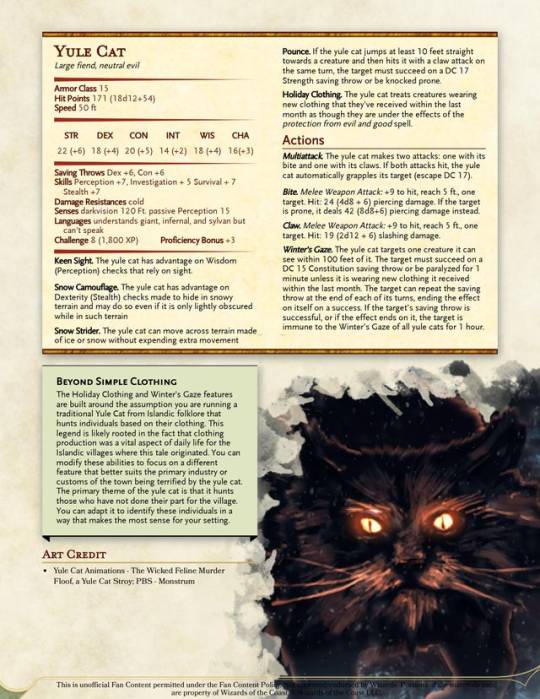
The massive scary Yule Cat from Icelandic Mythology has always amused me. I may have to write a One-Shot adventure for it some day. Homebrew monster stat-ed by Star Sail Games
#Yule Cat#Icelandic#Tradition#Mythology#Legend#Lore#Homebrew#Monster#Christmas#Star Sail Games#DnD#D&D#Dungeons and Dragons#5th Edition#5EDnD#Stats
481 notes
·
View notes
Photo


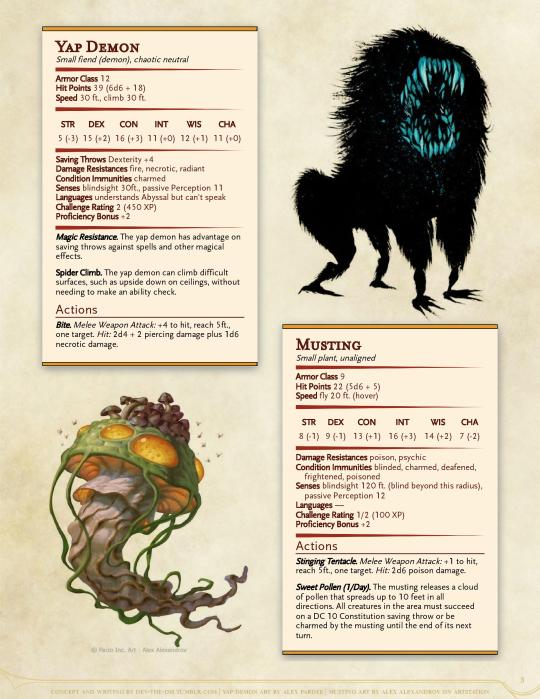


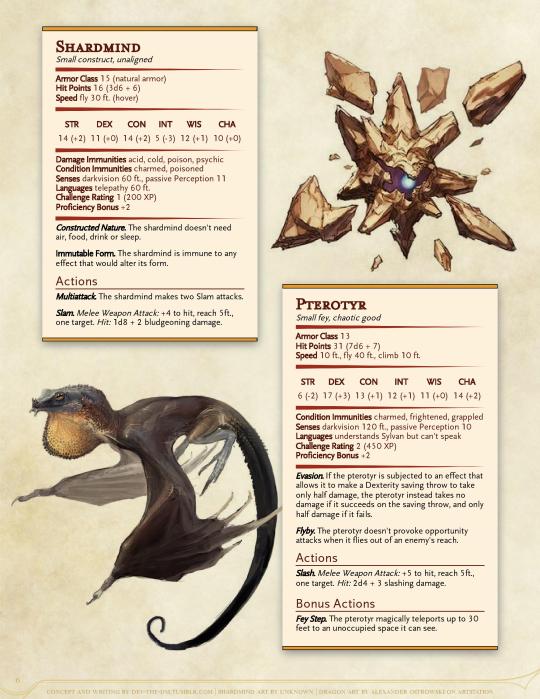
Collection: Arcane Familiars
Are you also bored with the current limited number of official familiars, whether you get yours through the find familiar spell or by befriending every imp that the DM throws your way? This should help! This collection contains eight new, unique familiars that are made distinct to fit every type of character that should want one. Additionally, each familiar has a trait or two that it can share with its bonded friend - but you may have to work for that.
For better, full-page high quality imagery, take a look at the Collection: Arcane Familiars at the Homebrewery here!
#dnd#dnd5e#d&d#d&d5e#dungeons and dragons#5th edition dungeons and dragons#d&d homebrew#dev's homebrews#creature stat block#fey#fiends#demons#plants#dragons#oozes#elementals#aberrations#constructs#cr1#cr1/4#cr1/2#cr2#cr3#features#collections
433 notes
·
View notes
Photo
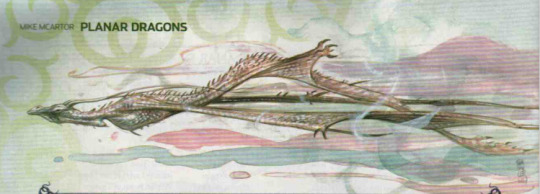
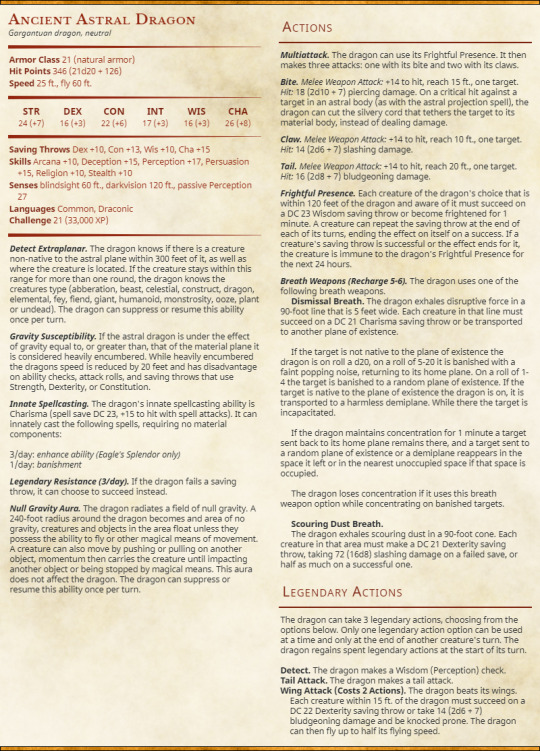

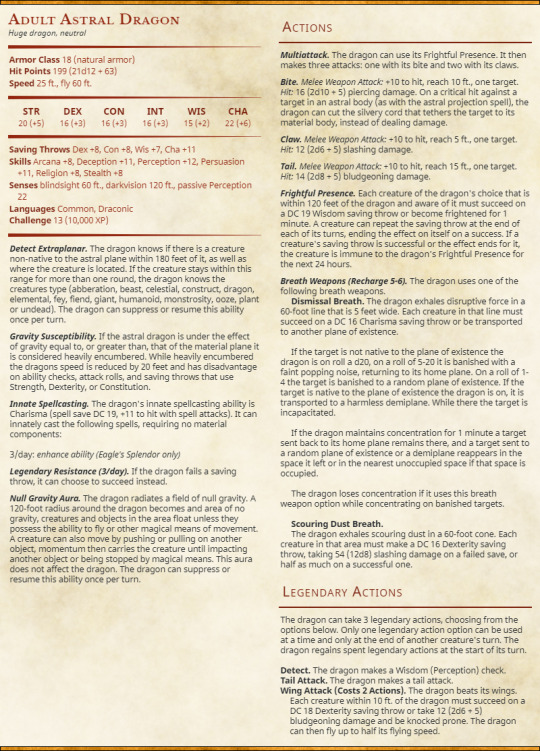

Channel: https://www.youtube.com/channel/UCPcFsxfrenLv_Nx0oxSmBhA
The Third version of the Astral Dragon, coming from 3.5e. Here are the converted stats to go with my lore video on these majetic dragons.
#dnd#Dungeons and Dragons#dungeons & dragons#dungeons and dragons 5e#d&d 5th edition#d&d 5e homebrew#d&d art#d&d stats#monster stats#stat block#Monster#dragon#planescape#dungeon master#dnd character#dnd 5e homebrew#dnd 5th edition
11 notes
·
View notes
Text
Getting Started: A Beginner's Guide to D&D | Medieval Collectibles

Dungeons & Dragons is a popular roleplaying game all over the nation. Let’s look at things you need to know when getting started with a beginner’s guide to D&D.
What Is Dungeons & Dragons?
Dungeons & Dragons is a fantasy tabletop role-playing game originally designed by Gary Gygax and Dave Arneson. It was first published in 1974 by Tactical Studies Rules, Inc. It was since published by Wizards of the Coast in 1997. Originally derived from miniature wargames, a variation of the 1971 game Chainmail served as the initial rule system. However, D&D departs from traditional wargaming by allowing each player to create their own character to play instead of a military formation.
The goal is for the characters to embark on imaginary adventures in a fantasy realm. They form a party and interact with the realm’s inhabitants and each other. They resolve issues, engage in battles, explore the world, and gather treasure and knowledge from everything and everyone around them. Through this process, the characters earn experience points (XP) to level up. They continue to gain powers and strength over several gaming sessions.
How to Play
D&D is normally played indoors with the participants seated around a tabletop. However, nowadays many people also use online resources like Discord, Roll20, and D&D Beyond to play together across great distances.
One player takes on the role of Dungeon Master (DM). The others each control a single character, representing an individual in a fictional setting. This group of individuals, when working together, is described as a “party” of adventurers. Each character often has their own area of specialty which contributes to the success of the whole group. Throughout the game, each player directs the actions of their character. They choose how to interact with other characters in the game. This is performed through verbal impersonation of the characters by the players, also known as role-playing. Many players also use miniature figures on a grid map as a visual aid, particularly for combat.
Keep reading the full article below or click here to read it on our website.
What Do You Need to Play?
If playing D&D in the general tabletop setting, players will need the following:
A character sheet – To keep track of their stats, weapons, abilities, and their character background information.
A rule book – Players can check out the Dungeons and Dragons: 5th Edition Rule Book. The official Dungeons and Dragons website also provides a free PDF version of the Basic Rules. It’s their version of a beginner’s guide to D&D.
One set of polyhedral dice – A set of these dice typically comes with 7 different dice. These include d4, d6, d8, d10, d12, d20, and d100. The “d” refers to the die itself, while the number refers to the number of sides on the die. This excludes the d100 as it has 10 sides. It is generally used as a percentile die by the DM rather than the players. Different polyhedral dice coincide with different actions. A d20 is used to see whether a hit was made in combat. However, a d8 is used to determine how much damage was dealt.
A pen or pencil – To keep track of their character’s information, and any important notes from the storyline.
Equipment for playing will be a little bit different if using online resources for gameplay. Sites like Roll20 and D&D Beyond allow players to have virtual character sheets, so there’s no reason to use pen and paper. If playing online, some DMs would rather their players use virtual dice as well to maintain honest gameplay. However, others may be lenient and allow players to roll their own physical dice. It’s still a good idea to have a copy of the rules on hand, whether physical or virtual.
Joining a Campaign or a One-Shot
Some D&D groups prefer short one-shots, while others prefer much longer campaigns. Most groups play a combination of both. A one-shot is a single-run adventure. These sessions are usually unconnected from a storyline or game world and can be finished in only a few hours. There is no connected plot, and the players can play different characters in each session. A campaign is a series of adventures that take place over multiple sessions. The player’s characters often remain as elements of the continuing story arc unless they meet an unfortunate demise. The DM can either use one of the many pre-made adventures that have been published throughout the history of D&D, or they can design their own original adventure. These are typically referred to as homebrew.
Should I Be a DM or a PC?
The Dungeon Master (DM) is the storyteller and host of the campaign or one-shot. They act as every NPC or BBEG that the party will encounter on their adventure. NPC stands for non-player character. BBEG stands for Big Bad Evil Guy. Their job is to set the scene for the party. They describe what other players perceive in this imaginary world, and how their actions affect the world around them. Typically, the Dungeon Master is someone who has a bit more experience playing D&D than the rest of the players, but don’t let that discourage you from giving it a try.
Player Characters (PCs) are the members who make up the party. Their job is to explore the imaginary world, traverse dungeons and forests, and unravel the stories around them. They make the decisions that will drive the story along, whether it be good or bad. Anyone can be a player character, no matter if they are new to the game or well-versed.

Character Creation
Players record the details of their character on a Character Sheet. A player will determine their character’s ability scores by rolling a d20 for each ability. Afterward players decide on a race for their character and their character’s class or occupation. They choose an alignment of morality and many other features to round out a character’s abilities and background. Some races give characters different advantages, like dark-vision, hereditary spells, or speaking other languages. Classes add to what characters can do on all fronts; stat improvements, proficiency in weapons or languages, or whether a character is able to use spells. For example, a cleric is well-versed in magic that comes from an in-game deity. A monk is more proficient in unarmed combat and can harness ki’s mystic energy. These two characters would have very different abilities.
The difficult part of character creation is usually coming up with a detailed background. Creating a background for a character allows the other party members to get to know the character better. It also helps the DM to weave a character’s story into the narrative more thoroughly. Most players will go into an adventurer without knowing a lot of the backstory if any at all. Depending on what kind of character the player created, the background could cause a character to act a certain way. This could be around friendly NPCs or foes, which in turn affects the rest of the party. For tips on creating your first D&D backstory, check out Crispy’s Tavern’s guide on Youtube, 6 Tips for Your First D&D Backstory – Tabletop Tavern Tips.
Abilities and Proficiencies
A character’s abilities include strength, dexterity, constitution, intelligence, wisdom, and charisma. The stats for these abilities are initially rolled during character creation. Each ability score will determine an ability modifier that characters can apply when rolling an ability check. Let’s say a player rolls a d20 for an ability score. If they were to get a 14 or 15, their ability modifier would be +2. Proficiency bonuses are also determined by character creation. However, these depend on race or class and are only applied when rolling for specific skill checks.
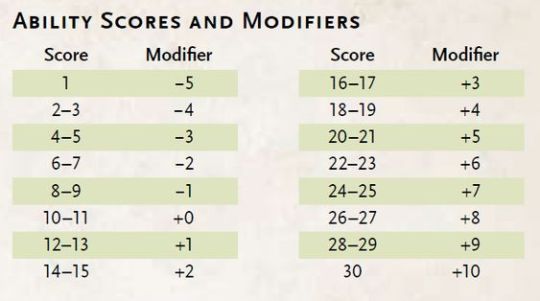
Role-Playing My Character
Once the characters are made and the first session is decided, it’s time to prepare to become the character. Depending on the background and character, different players will roleplay in different ways. A Lawful Good Wizard and a Chaotic Evil Paladin would not act the same. And if one was an elf and one was a paladin, they would have different accents. But getting into character can be hard for a first-time player. Keeping the same accent for an entire campaign can be difficult. Some people recommend recording the character’s “voice” to listen to before the session to get into character. For other tips on role-playing in D&D, check out Crispy’s Taverns guide on Youtube, How to Start Roleplaying in D&D (Making RP Easier) – Tabletop Tavern Tips.
Actions and Combat In-Game
Depending on what actions a character takes, they will have to make a roll to see how their action prevails. Certain actions a character chooses to do are automatically successful. This could be picking ale up at the tavern or opening an unlocked door. Other actions, liking attacking an opponent or picking a lock, must be discussed with the DM. The player will then roll a dice to see if it is successful or not. This is where ability modifiers and proficiencies come into play. Before combat the DM will ask the player to roll initiative, which is a d20 plus your dexterity modifier. Initiative is how players decide what order the characters will go in during combat.
Let’s say during combat, an opponent has an Armour Class (AC) of 17. The player rolls a 15 on a Strength attack. They will have to add their ability modifier to their roll to successfully hit the opponent. After a successful hit, the player will roll for damage. The dice they roll for damage depends on the weapon they use to attack. For example, a quarterstaff causes a d6 of bludgeoning damage.
In this article, we looked at the things you need to know when getting started with a beginner’s guide to D&D. We explored how to play, the tools needed for play, character creation, and other important topics when deciding to join a session of Dungeons & Dragons.
#guide to dnd#dnd5e#dnd#d&d#dungeons and dragons#intro to dnd#dnd guide#what is dnd#how to play dnd#how to play dungeons and dragons#beginner's guide to dnd#dnd stuff#dnd class#medieval collectibles#blog#article
74 notes
·
View notes
Text
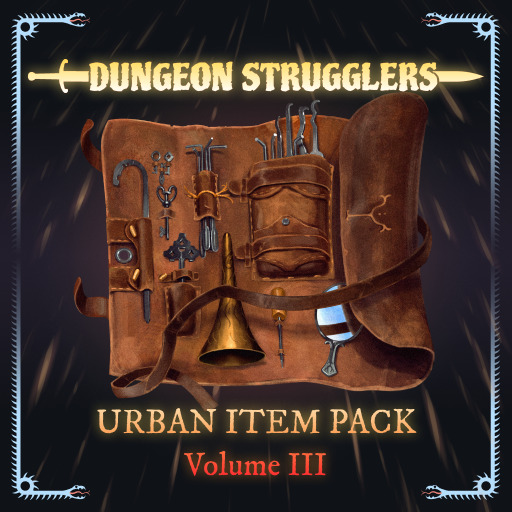
Dungeon Strugglers' Urban Item Pack: Volume III is now out on the Roll20 Marketplace!
Unlock the treasure hoard of the urban cityscape!
This pack contains 10 beautifully illustrated, mechanically balanced and deftly written items for Dungeons and Dragons: 5th Edition. This body of work adds unique and interesting flavor to any campaign, and enhances the experience for your players to discover as they explore the crowded streets and back-alleys of your world!
Contents of this pack:
10 ready-to-use items and their accompanying hi-res art, mechanics and lore.
Metadata tagging, a table of contents and notes on usage for painless setup.
Unidentified & Identified versions of all Item Handouts.
The Prismatic Parliament Set - a menagerie of equipment from the City of Colors!
You can find the Urban Item Pack: Volume 3 here, or by searching on the Roll20 Marketplace.
All of our Roll20 wares can be found on our publisher page here.
-
🖌🎨 Like our work? Consider supporting us on Patreon and gain access to the hi-resolution art for over 145 magic items, item cards and card packs, beautiful monster art and stat blocks, monthly setting pdfs with narrative hooks and unique lore, and vote for the content you want to see!🧙♂️
📜 Credit. Art and design by us: the Dungeon Strugglers. Please credit us if you repost elsewhere.
#dungeon strugglers#roll20#dnd#artists on tumblr#d&d#illustration#critical role#dnd item#fantasy art#ttrpg#animation#artwork#d&d 5th edition#dnd 5th edition#dnd 5e#d&d 5e#5e#dnd 5e homebrew#d&d homebrew#dnd homebrew#homebrew#drawings#digital art#drawing#dnd characters#vtt#vttrpg#ttrpg homebrew#tabletop
70 notes
·
View notes